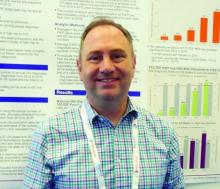AMSTERDAM – Preexposure prophylaxis (PrEP) against HIV infection by U.S. residents appears to be paying off: The number of new U.S. HIV infections among those at least 13 years old dropped during 2012-2016, and this decline showed a statistically significant link with growth in drug prophylaxis among U.S. residents during the same time.
Uptake of HIV PrEP “was significantly associated with declines in HIV diagnoses in the United States, independent of levels of viral suppression,” Patrick S. Sullivan, Ph.D., and his associates said in a poster presented at the 22nd International AIDS Conference.
Their analysis of nationwide U.S. data showed that during 2012-2016 new HIV diagnoses in residents at least 13 years old fell by an estimated annual percent change of 4.65 among the 10 states with the greatest rate of PrEP use by residents, compared with increases in the estimated annual percent change in new HIV diagnoses of about 1-1.5 in the 14 states with the lowest PrEP use. This statistically significant link remained after adjusting for variations in levels of viral suppression among HIV-infected residents in each state, another factor driving reduced infection rates, Dr. Sullivan and his associates reported..
In the ten-state subgroup with the greatest PrEP uptake, use of PrEP in people at risk for HIV rose from 12/1,000 people in 2012, the year that the Food and Drug Administration first approved a PrEP regimen, to 110/1,000 at-risk people in 2016, a ninefold increase. PrEP use jumped by about the same relative amount in the seven states with the lowest PrEP use, but because it was only 3/1,000 people in 2012 it reached only 35/1,000 in 2016, less than a third of the rate in the states that administered the most PrEP.
In absolute, unadjusted numbers the rate of new HIV diagnoses in the 10 states with the greatest PrEP use fell from 19.4 cases/100,000 population to 13.6/100,000 in 2016. Total U.S. HIV diagnosis rates in people at least 13 years old fell from 15.7/100,000 in 2012 to 14.5/100,000 in 2016, reported Dr. Sullivan, a professor of epidemiology at Emory University in Atlanta.
Dr. Sullivan and his coauthors cautioned that these associations do not allow inference of a causal relationship, and their data did not allow them to estimate the relative contributions of PrEP uptake and HIV suppression to the declining trend in diagnosed HIV infections. However PrEP and suppressive HIV treatment act in a complimentary way to potentially drop the rate of new HIV transmissions, he said.
In the years since 2012, when the Food and Drug Administration approved PrEP as an indication for 200-mg emtricitabine (Emtriva) and 300 mg tenofovir (Viread) – formulated into a single pill and marketed as Truvada, the idea of PrEP for people at increased risk for HIV exposure has gained traction.
Awareness of, knowledge about, and uptake of PrEP have all increased among U.S. residents since a PrEP formulation became available, Dr. Sullivan said. It’s become a cultural norm in at least some communities, he said in an interview. The cost for daily PrEP has posed a barrier to some potential users, but in many U.S. settings people can find ways to at least partially subsidize the cost even when lacking insurance coverage for the drug, he noted.
To determine rates of new U.S. HIV diagnoses Dr. Sullivan and his associates used data collected by the National HIV Surveillance System. To estimate rates of PrEP uptake they used data from prescriptions filled for the emtricitabine and tenofovir formulation that they then adjusted to rule out use for indications other than PrEP (Ann Epidemiol. 2018 Jun 22. doi: 10.1016/j.annepidem.2018.06.009).
SOURCE: Sullivan PS et al. AIDS 2018, Abstract 13004.


